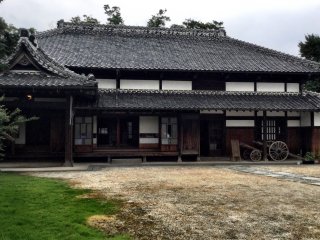Nakamura family legend has it that their ancestors in the 16th century were aligned to a retainer of the Tokugawa shogun. After the Battle of Sekigahara in 1600, the Nakamuras settled not far from Edo and the Tokugawa shogunate in Musashi Province, in present day Koshigaya City. With their high status, they took on the task of managing the town of Omanocho as nanushi, village headmen.
The social stature and wealth of the family are attested to in the beautifully restored and preserved buildings and household goods. The main house, omoya, built in 1914 is constructed of massive rough-hewn beams and a central pillar of zelkova wood measuring 35 cm. Visitors enter in the doma, the earthen floored kitchen. From there, visiotrs step up into the elegant but functional living space. Delicate ranma transoms and etched glass panels in the doors are hallmarks of Taisho style. Curators have gathered period household items and kitchen equipment that give the impression of a busy family and staff.
Tucked in the garden behind the house is a fine example of a kura storehouse. This two story dozou, or earthen storehouse with a deep cellar has fire doors 60 cm thick. Inside, the family stored precious items in the fire- and vermin-proof building. On display are nagamochi, huge chests for storing out of season household goods, and a stair-step tansu chest leading to the second floor.
The low-slung nagayamon gatehouse built in 1886 contains equipment that was essential for farming and fire protection. Some implements may look familiar to visitors from abroad, and others challenge you to imagine how they were used in rice and soy bean production. Also on display are vintage pumper trucks on loan from Adachi Ward and Koshigaya City.
If you are still curious about farm life in ages past in Koshigaya, visit the other Former Nakamura Residence, the home of a village leading family established in the Edo Period. Make a day of your visit by returning to the modern world at nearby Koshigaya LakeTown.












































